Arc Discharge–Induced Ignition of Combustibles Placed on a Damaged AC Power Supply Cord
Abstract
1. Introduction
2. Arc at Short Circuits Caused by Contact of Broken Element Conductors
2.1. Sample
2.2. Experimental Procedures
2.3. Results and Discussion
- (1)
- Mechanical forces break some of the element conductors, thus allowing the formation of a partially broken part in the power supply cord.
- (2)
- At the partially broken part, the current runs through the remaining intact element conductors, which results in a rise in temperature of the PVC due to a large amount of Joule heat.
- (3)
- The softened PVC releases a tightening force applied to the element conductors.
- (4)
- The broken element conductor in one cable of the cord pierces and breaks through the PVC between cables and comes into contact with other element conductors in the other cable, probably by shrinkage stress acting on PVC during the cooling process when the current supply is paused.
- (5)
- Since the element conductor bridges conductors of two cables by the end of a cooling process, a short circuit occurs immediately or shortly when current flows again in the next cycle, and an arc generates.
- (6)
- By coming into contact with an arc or a piece of melted element conductor, a minute portion of the combustible occasionally reaches its flash point temperature, which results in probabilistic ignition.
3. Arc Caused by the Breakage of Intact Element Conductor
3.1. Sample
3.2. Experimental Procedures
3.3. Results and Discussion
- (1)
- An external mechanical force breaks most of the element conductors of a power supply cord.
- (2)
- Current runs through the intact element conductors and its temperature rises because of Joule heating.
- (3)
- The intact element conductors melt and arc generates.
- (4)
- The temperature of a minute portion of the combustibles occasionally reaches the flash point through contact with arc or a piece of the melted element conductor, which results in the probabilistic ignition of combustibles.
4. Possible Arc Detection Feature
- (1)
- The deviation time is 70 μs or longer in a half cycle.
- (2)
- Current becomes zero within the next half cycle.
5. Conclusions
Author Contributions
Funding
Acknowledgments
Conflicts of Interest
References
- Tokyo Fire Department. Survey of Fires Accidents in 2019. Available online: http://www.tfd.metro.tokyo.jp/hp-cyousaka/kasaijittai/h31/ (accessed on 18 December 2019).
- Committee for Investigating Electric Fire Prevention Methods at a Big Earthquake. Report of Investigation and Promotion of Electric Fire Prevention Methods at a Big Earthquake. 2015, pp. 11–13. Available online: http://www.bousai.go.jp/jishin/syuto/denkikasaitaisaku/pdf/guideline_houkoku.pdf (accessed on 18 December 2019).
- Gregory, G.D.; Wong, K.; Dvorak, R.F. More About Arc-Fault Circuit Interrupters. Ieee Trans. Ind. Appl. 2004, 40, 1006–1011. [Google Scholar] [CrossRef]
- Abe, T.; Fukagawa, K.; Mizuno, Y.; Yoshida, A. Arc Discharge Detection Caused by Short-Circuit in Ac Power Supply Cord. In Proceedings of the IEEE Conference on Electrical Insulation and Dielectric Phenomena, Toronto, Canada, 16–19 October 2016. Paper No. 4B-21. [Google Scholar]
- UL 1699. Standard for Safety, Arc-Fault Circuit-Interrupters, 3rd ed.; UL: Bensenville, IL, USA, 2017. [Google Scholar]
- IEC 62606. General Requirements for Arc Fault Detection Devices, 1st ed.; International Electrotechnical Commission: Geneva, Switzerland, 2017. [Google Scholar]
- Shea, J.J. Comparing 240 Vrms to 120 Vrms Series Arcing Faults in Residential Wire. In Proceedings of the 54th IEEE Holm Conference on Electrical Contacts, Orlando, FL, USA, 27–29 October 2008; pp. 218–224. [Google Scholar]
- Shea, J.J. Identifying Causes for Certain Types of Electrically Initiated Fires in Residential Circuit. Fire Mater. 2011, 35, 19–42. [Google Scholar] [CrossRef]
- Kato, K.; Kataoka, M. Study of the Electric Fire Mechanism Caused by the Fault of Electric Cords for Domestic Use. Rep. Fire Technol. Saf. Lab. 2000, 37, 144–150. [Google Scholar]
- Awart, J.; Loud, J.; Slee, D. Arcing and Fire–Case Studies. In Proceedings of the IEEE Symposium on Product Compliance Engineering, Toronto, ON, Canada, 26–28 October 2009. [Google Scholar]
- Shea, J.J. Conditions for Series Arcing Phenomena in PVC Wiring. IEEE Trans. Compon. Packag. Technol. 2007, 30, 532–539. [Google Scholar] [CrossRef]
- Ishikawa, Y.; Takenaka, K.; Mizuno, Y.; Yoshida, A. Discharge-Induced Ignition of Combustibles on Ac Power-Supply Cords. In Proceedings of the IEEE Conference on Electrical Insulation and Dielectric Phenomena, Cancun, Mexico, 21–24 October 2018. Paper No. 6A-13. [Google Scholar]
- Restrepo, C.; Staley, P.S. Systems, Devices, and Methods for Arc Fault Detection. US Patent 0252603 A1, 1 November 2007. [Google Scholar]
- Ji, H.-K.; Wang, G.; Kim, W.-H.; Kil, G.-S. Optimal Design of a Band Pass Filter and an Algorithm for Series Arc Detection. Energies 2018, 11, 992. [Google Scholar] [CrossRef]
- Wu, C.J.; Liu, Y.W. Smart detection technology of serial arc fault on low-voltage indoor power lines. Int. J. Electr. Power Energy Syst. 2015, 69, 391–398. [Google Scholar] [CrossRef]
- Yang, K.; Zhang, R.; Yang, J.; Liu, C.; Chen, S.; Zhang, F. A Novel Arc Fault Detector for Early Detection of Electrical Fires. Sensors 2016, 16, 500. [Google Scholar] [CrossRef] [PubMed]
- Parise, G.; Parise, L. Unprotected Faults of Electrical and Extension Cords in AC and DC Systems. IEEE Trans. Ind. Appl. 2014, 50, 4–9. [Google Scholar] [CrossRef]
- Moon, W.-S.; Kim, J.-C.; Jo, A.; Bang, S.-B. Ignition Characteristics of Residential Series Arc Faults in 220-V HIV Wires. IEEE Trans. Ind. Appl. 2015, 51, 2054–2059. [Google Scholar] [CrossRef]
- JIS C 3005. Test Methods for Rubber or Plastic Insulated Wires and Cables; Japanese Standards Association: Tokyo, Japan, 2014; Section 4.27. [Google Scholar]
- Polymer Properties Database. Available online: http://polymerdatabase.com/polymers/polyvinylchloride.html (accessed on 18 December 2019).
- Takenaka, K.; Mizuno, Y.; Yoshida, A. Condition Monitoring of Damaged AC Power Supply Cord Using Voltage Waveform. In Proceedings of the International Conference on Condition Monitoring and Diagnosis (CMD2018), Perth, Australia, 23–26 September 2018. Paper No. P.47. [Google Scholar]

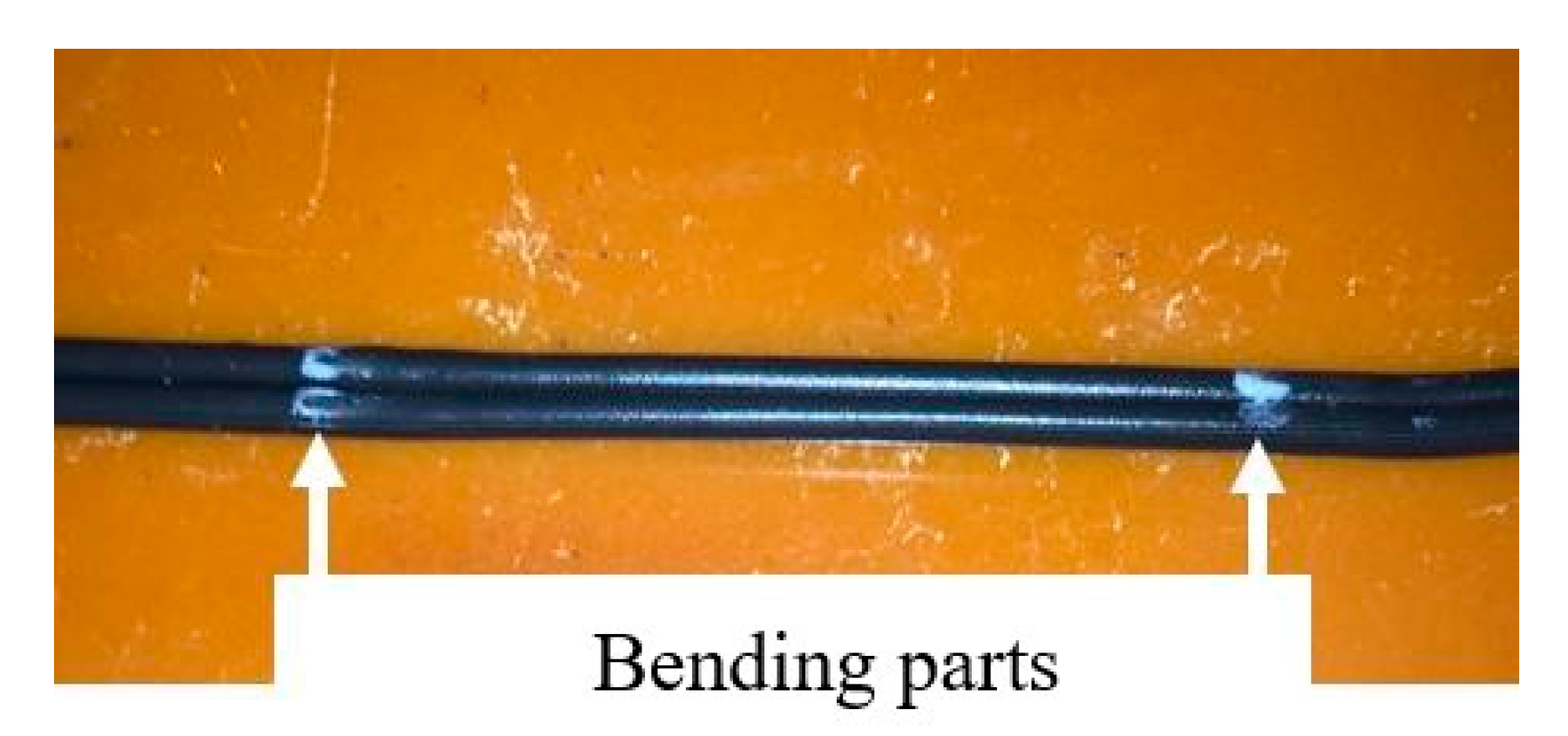
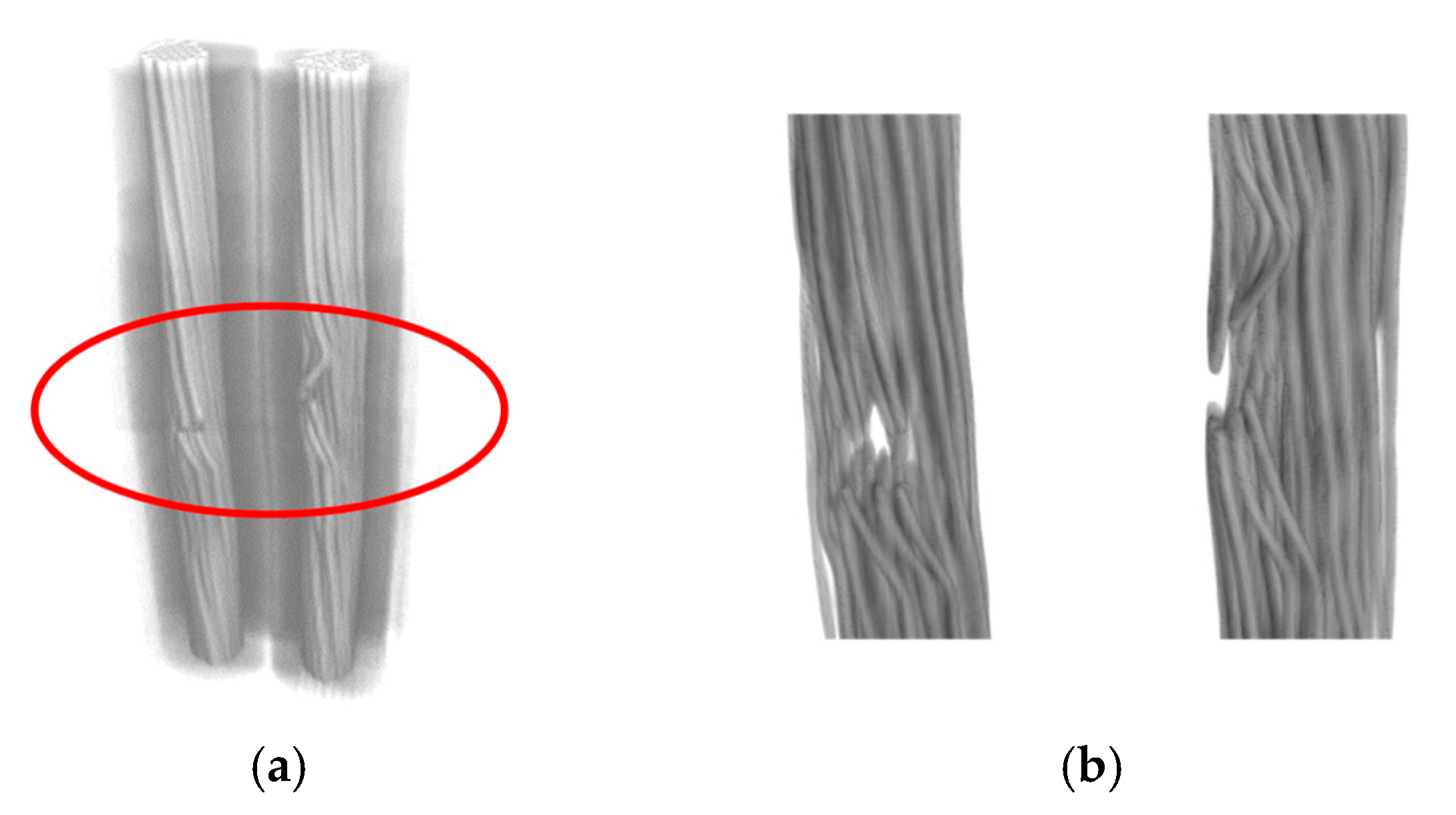
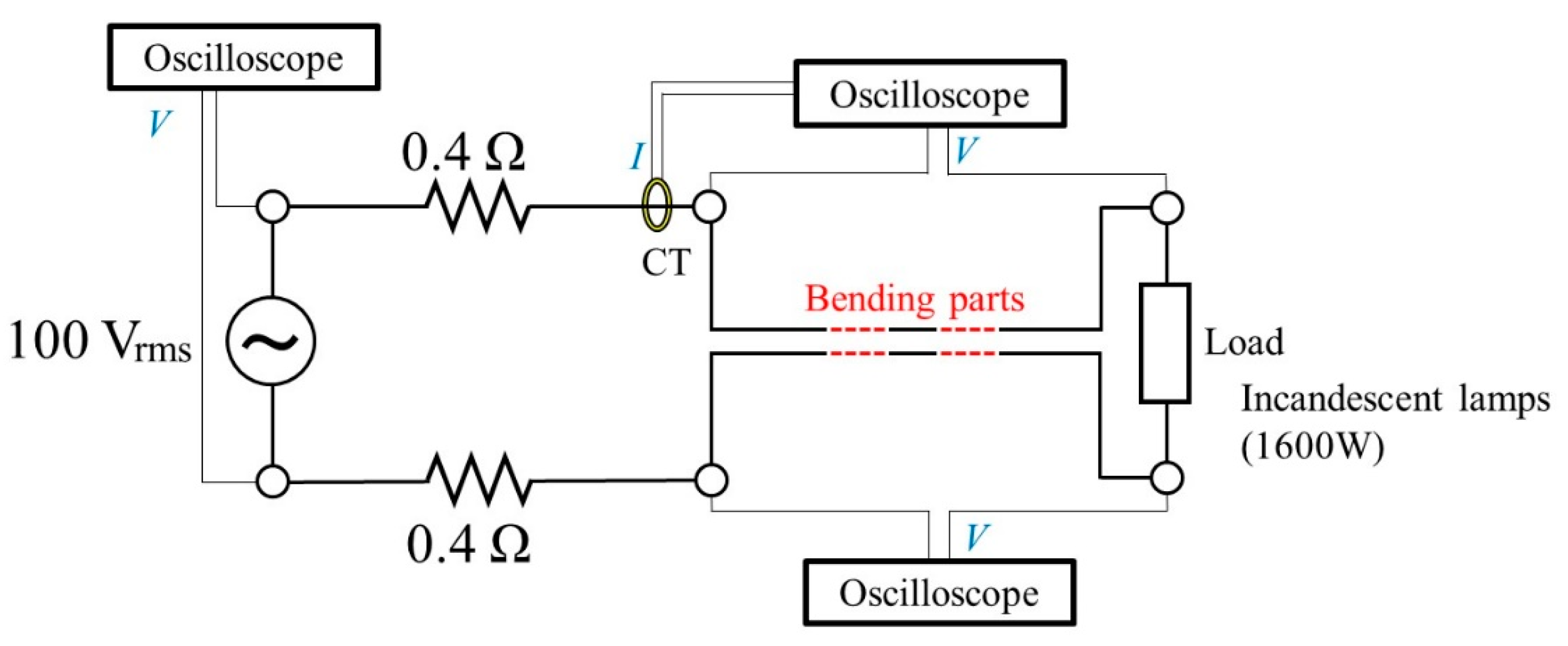
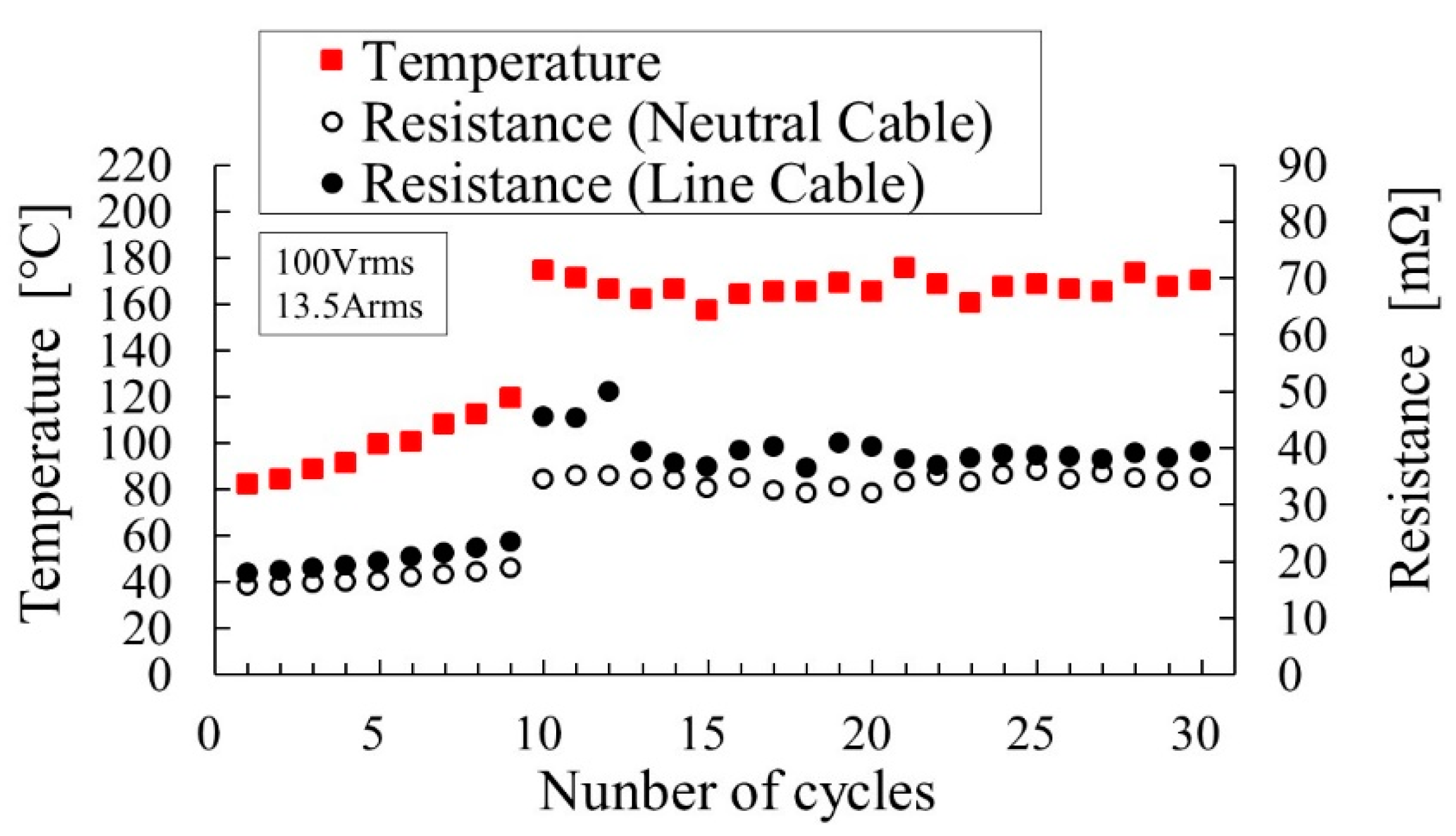
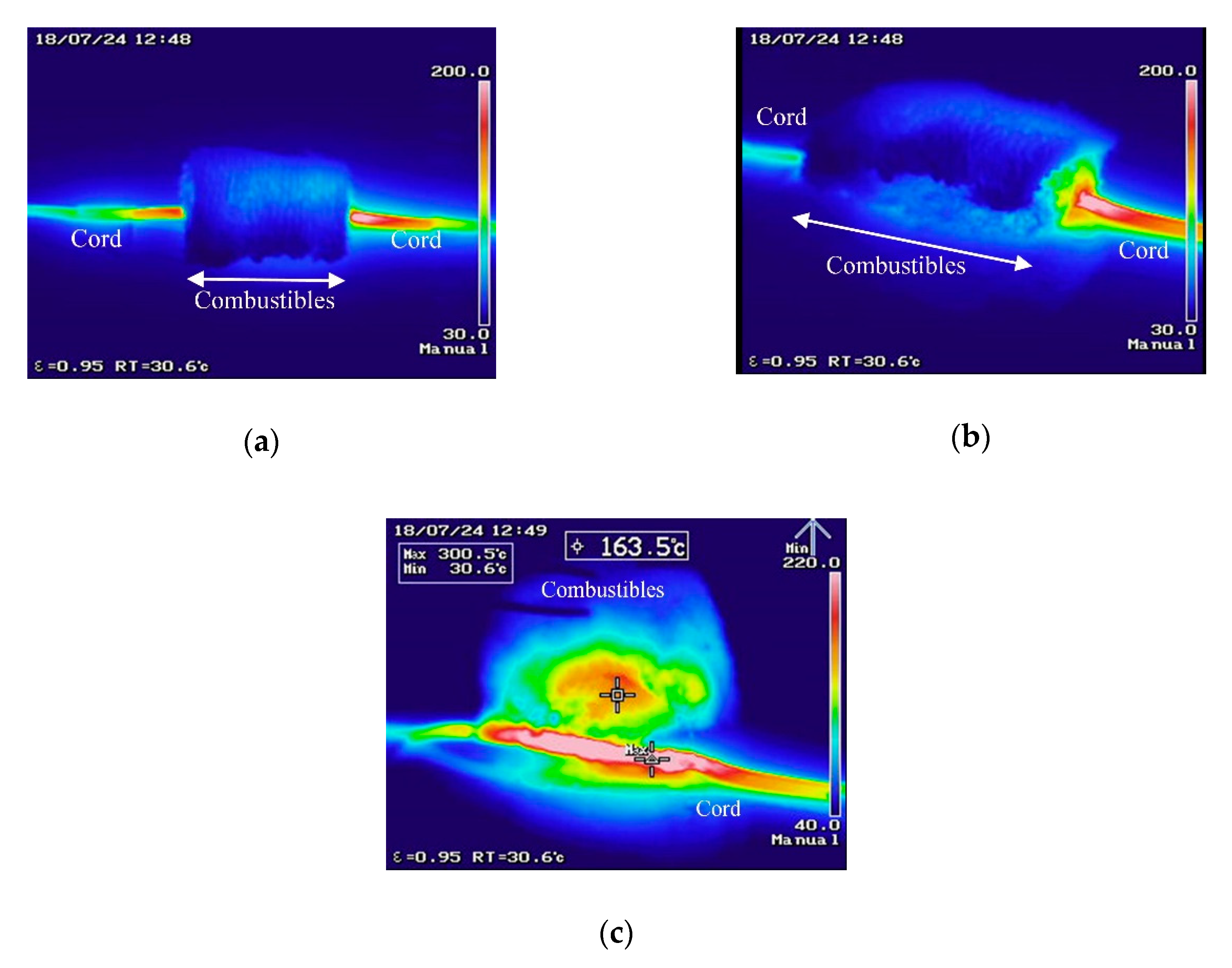
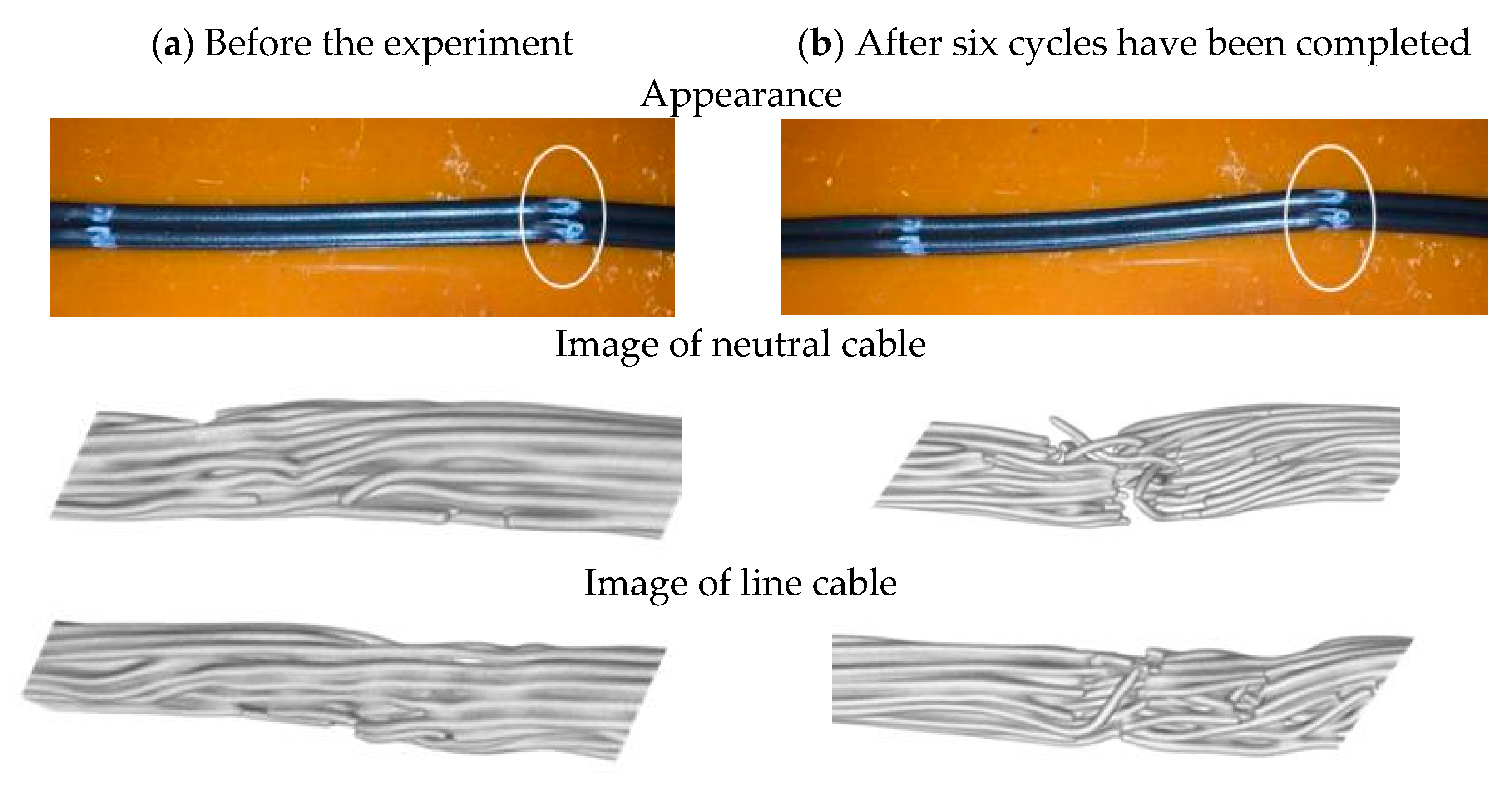
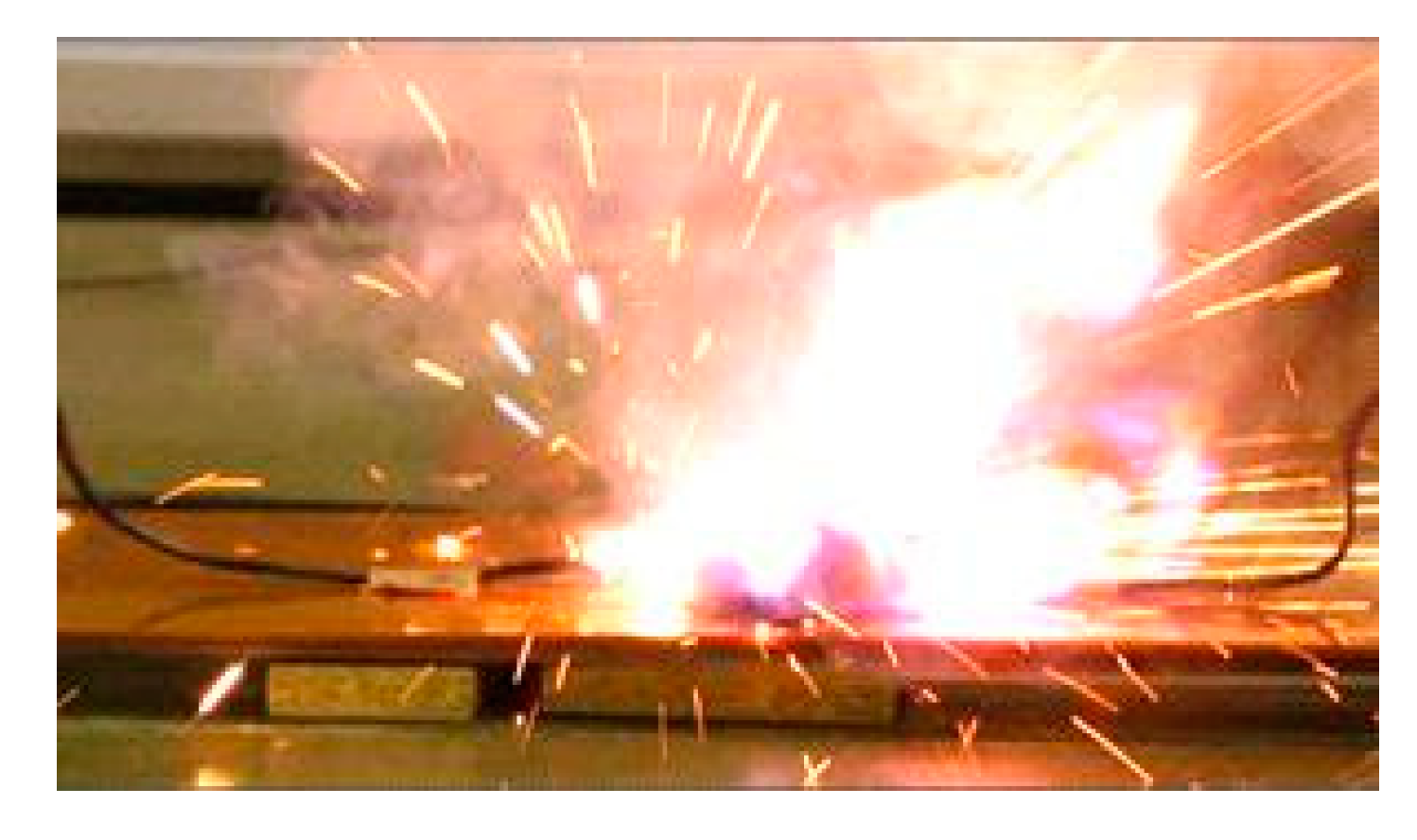
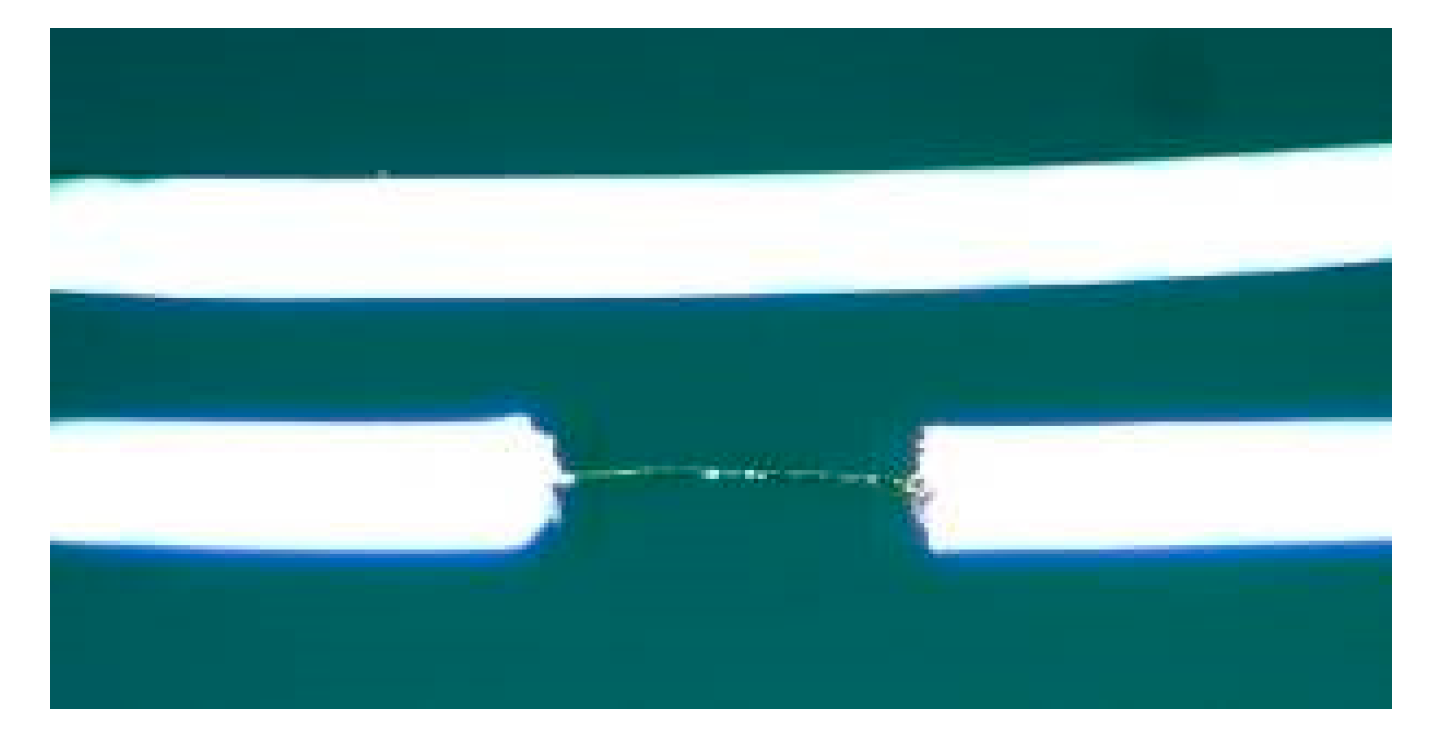

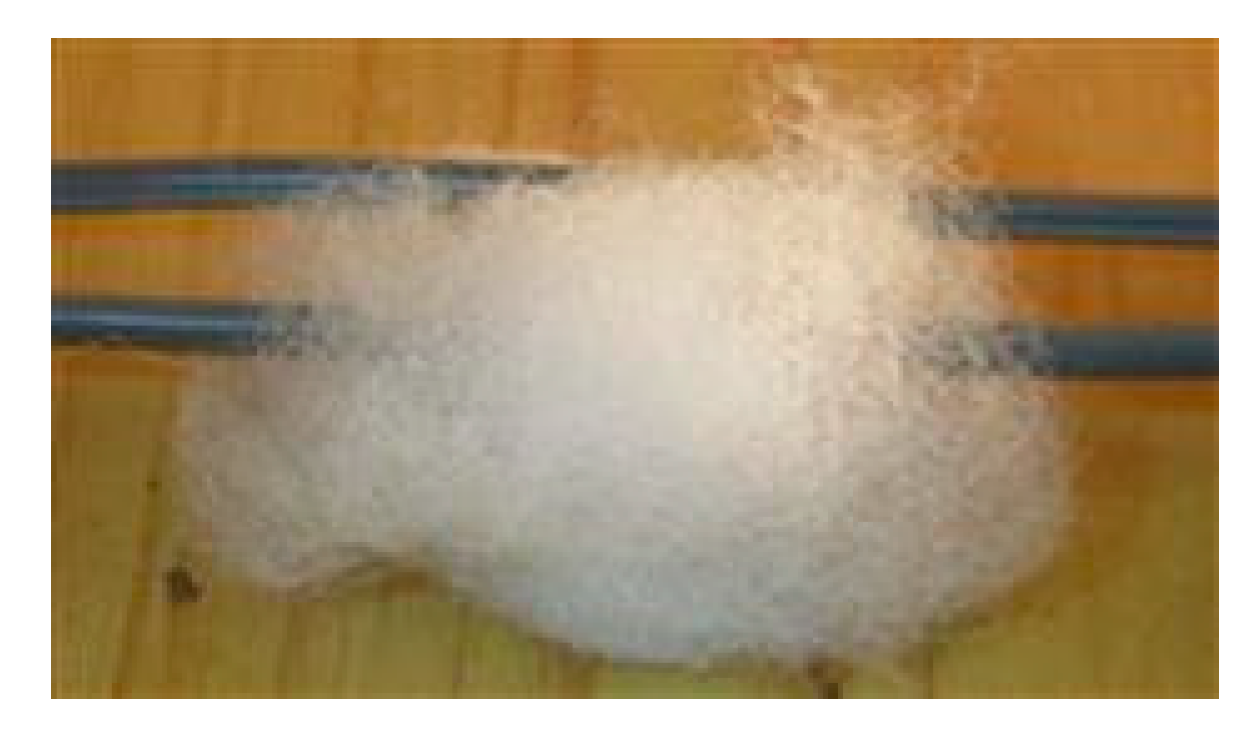


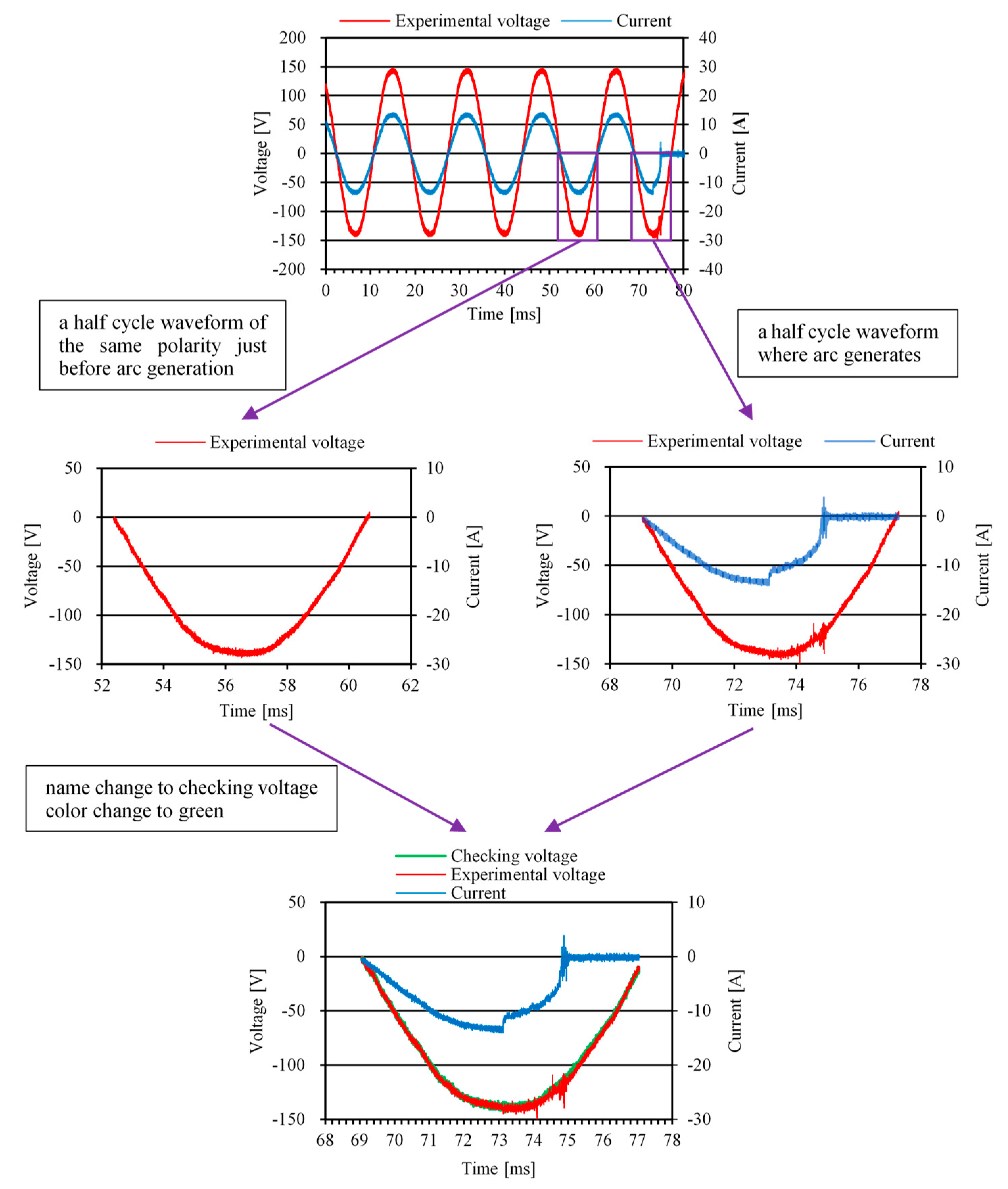
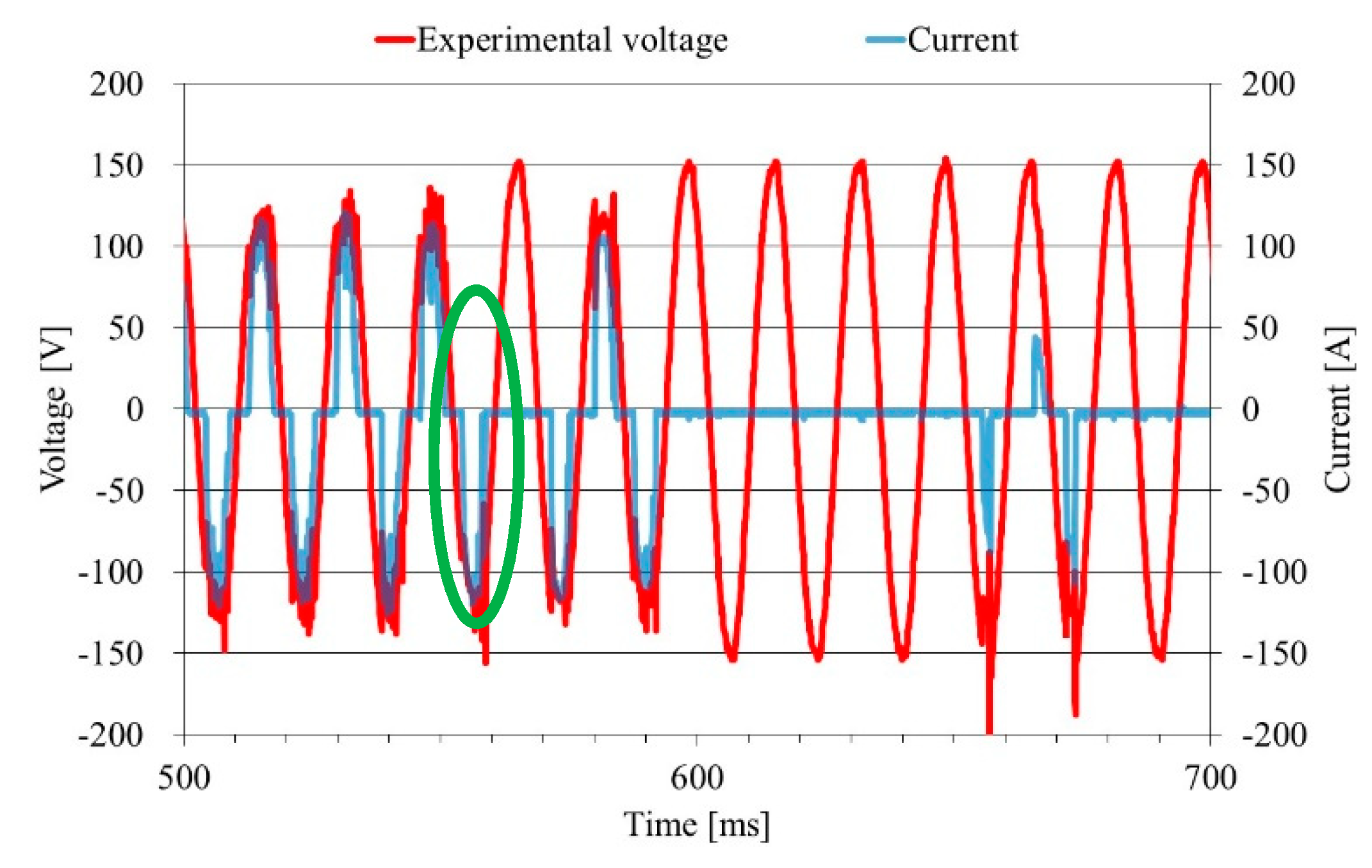
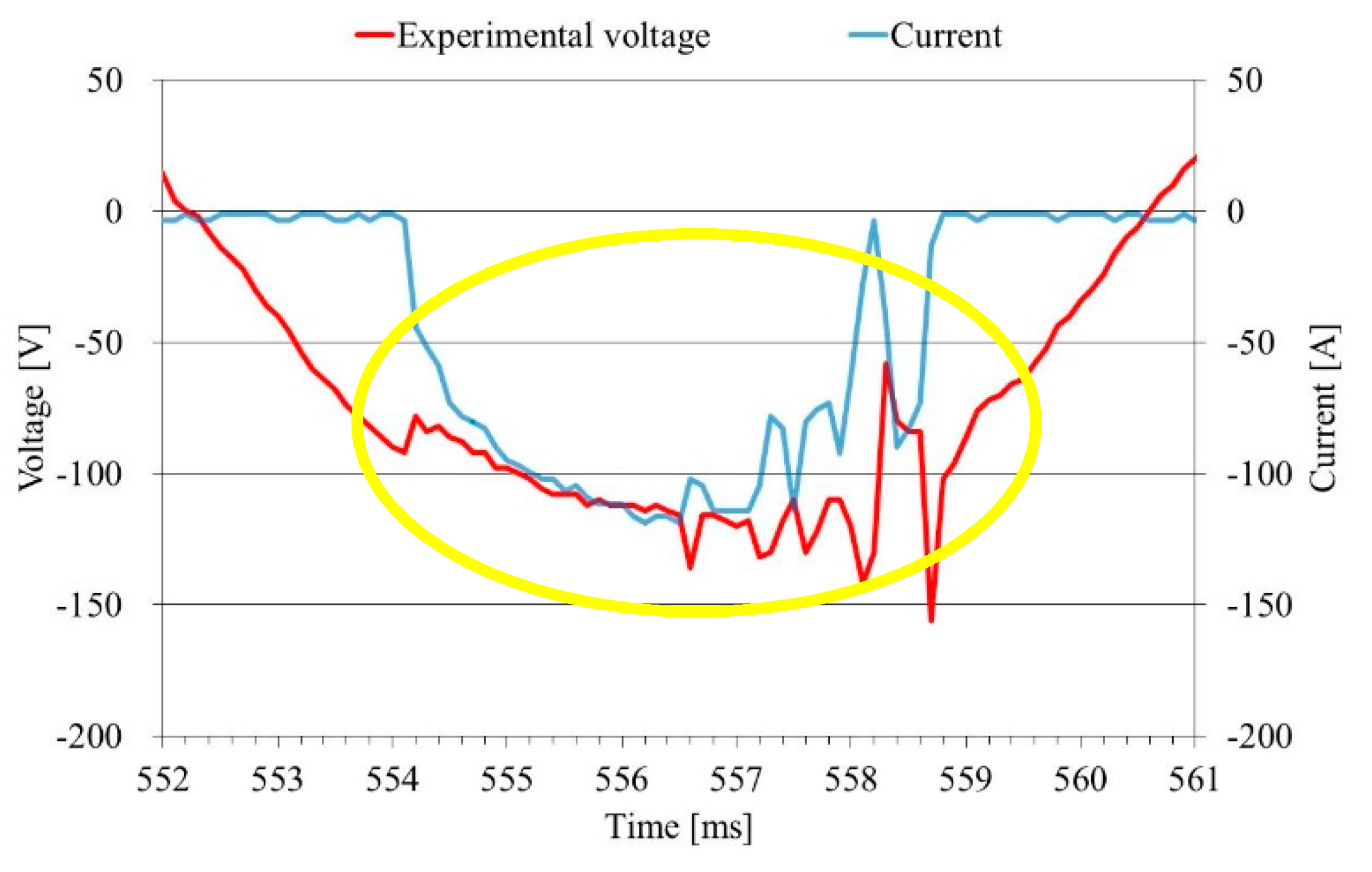
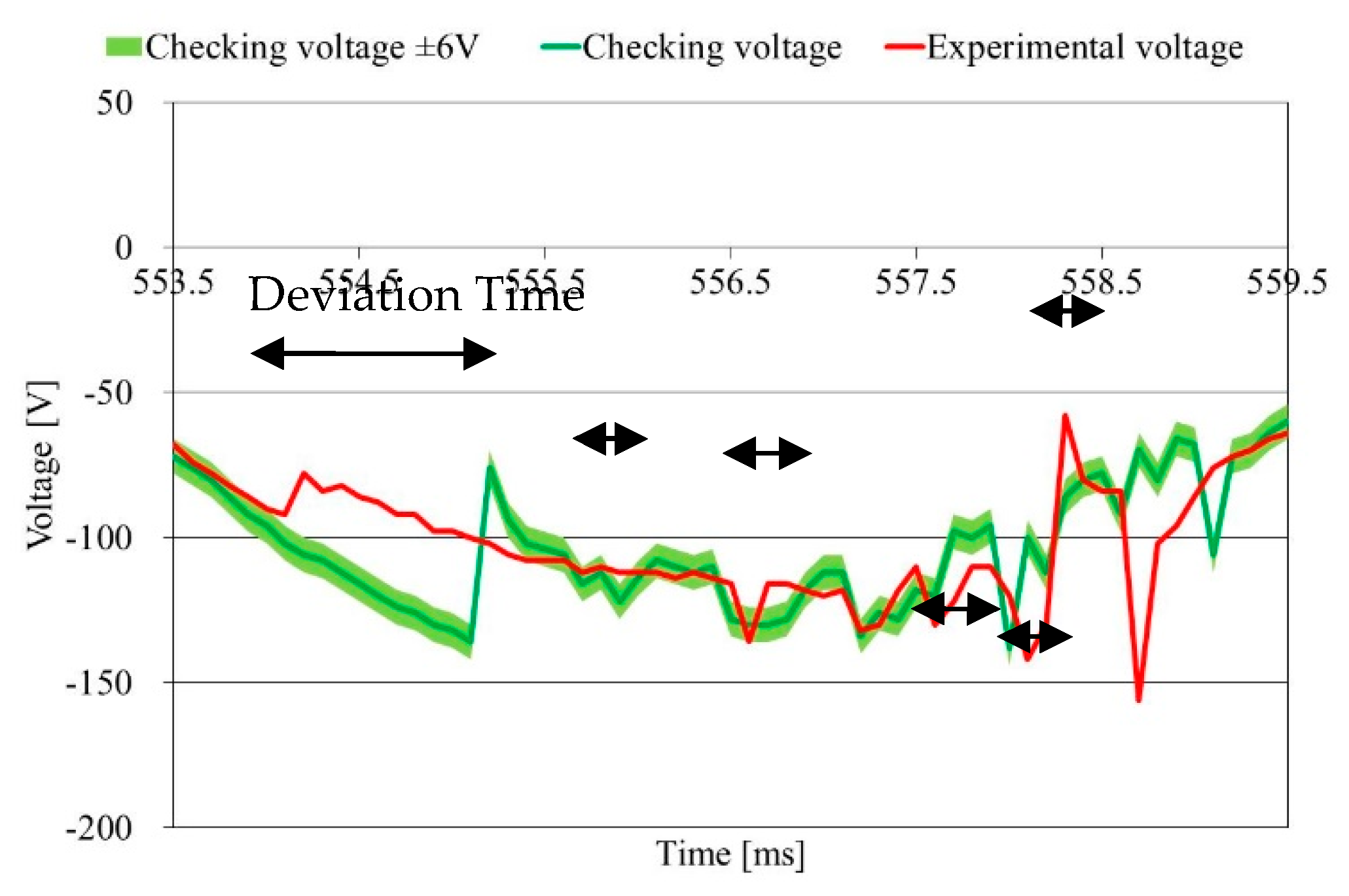
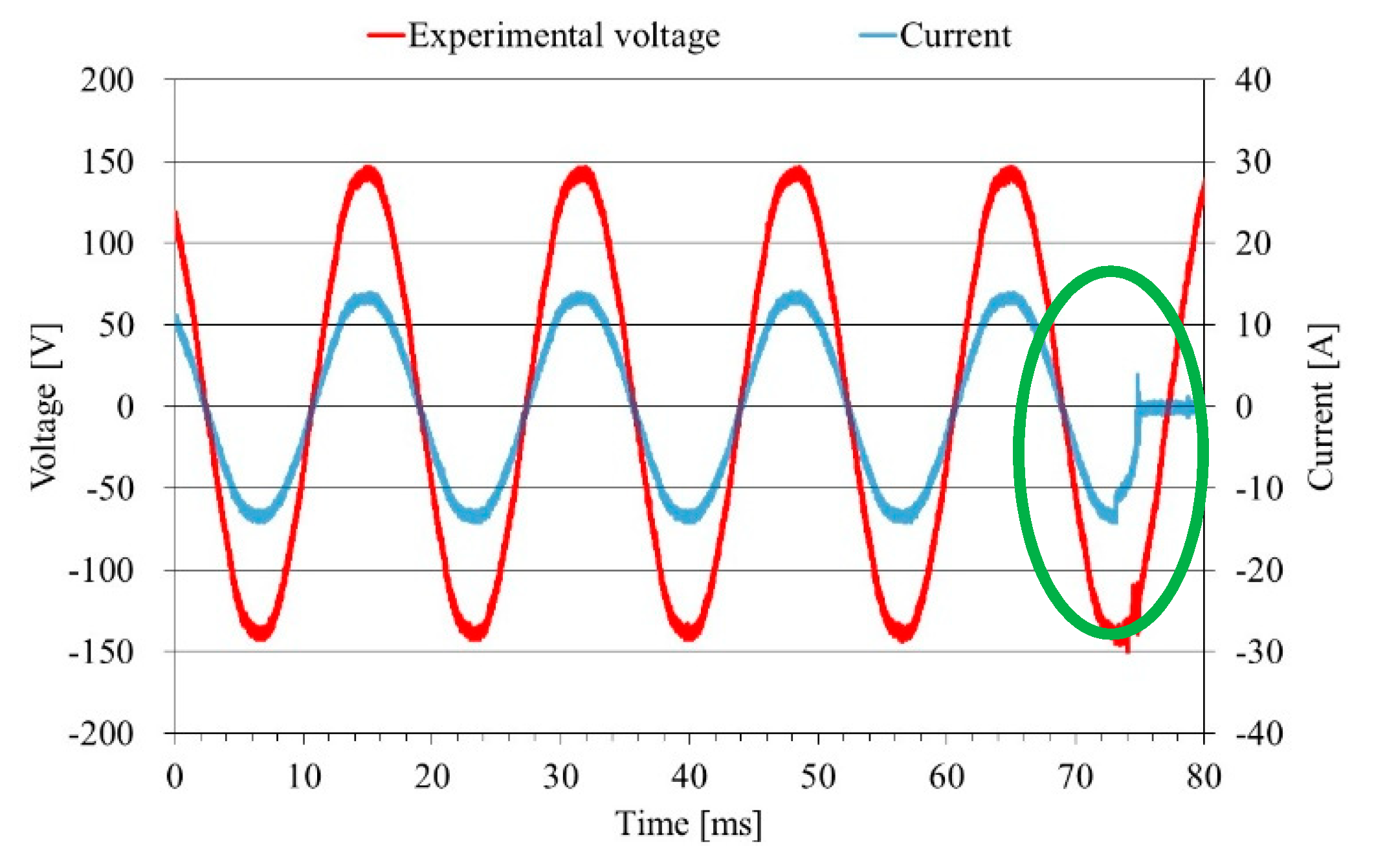
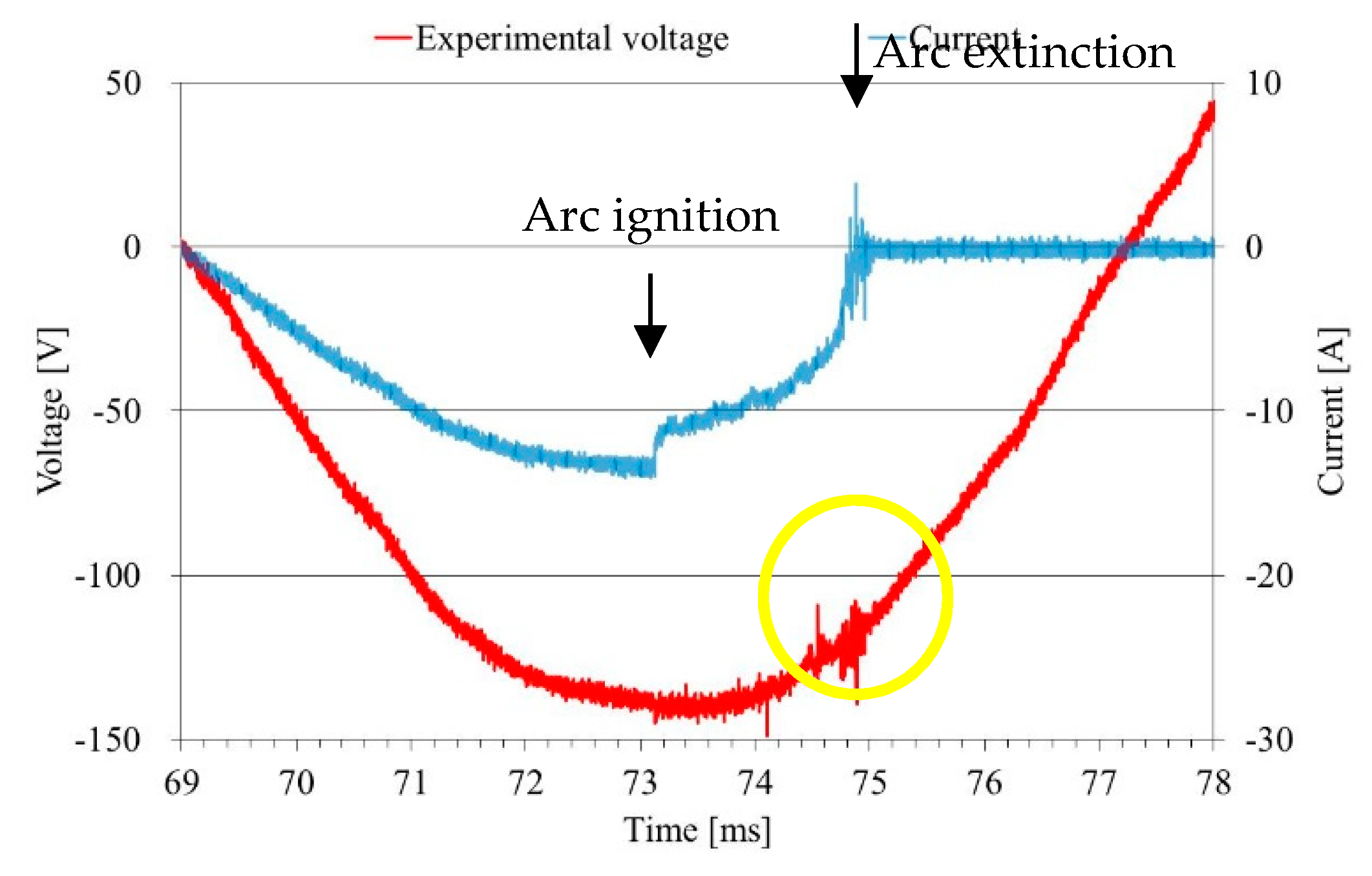
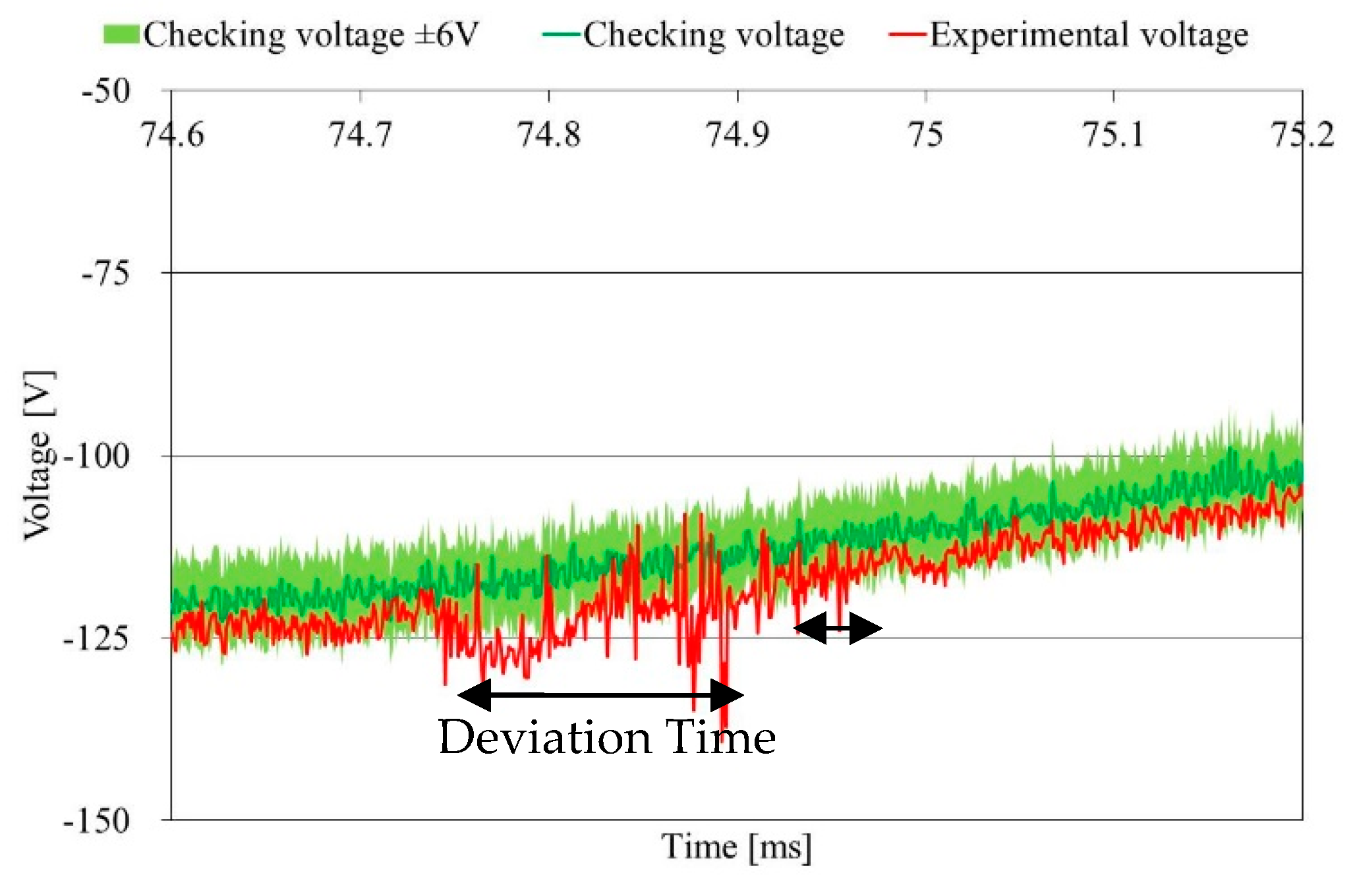
| Origin | Number of Fires | Percentage (%) |
|---|---|---|
| Electrical appliances (microwaves, rechargeable batteries, etc.) | 448 | 37.2 |
| Wiring (power supply cords, interior wirings, etc.) | 260 | 21.6 |
| Electrothermal apparatus (electric heaters, cooking heaters, etc.) | 222 | 18.4 |
| Wiring accessories (plugs, outlets, etc.) | 202 | 16.8 |
| Electric apparatus (low-voltage capacitors, transformers, etc.) | 68 | 5.6 |
| Others | 5 | 0.04 |
| Number of bending times | 180 (reciprocation) |
| Bend radius | 2.5 mm |
| Bending rate | 10 times/min |
| Load | 500 g |
| Sample No. | Temperature (°C) | Characteristics of the Short Circuit | |||
|---|---|---|---|---|---|
| No. of Cycles | Commencement Time | Current (Arms) | Duration (ms) | ||
| 1 | 175.2 | 31 | 122ms | 80.6 | 1,070 |
| 2 | 212.4 | 25 | 67.1ms | 71.9 | 240 |
| 3 | 225.0 | 38 | 30.0ms | 86.1 | 560 |
| 4 | 223.0 | 5 | 10min | 87.6 | 850 |
| 5 | 224.0 | 15 | Immediately | 51.2 | 80 |
| 6 | 231.0 | 5 | Immediately | 30.0 | 21 |
| 7 | 213.0 | 13 | 25.3ms | 93.4 | 253 |
| 8 | 186.6 | 23 | Immediately | 44.5 | 83 |
© 2020 by the authors. Licensee MDPI, Basel, Switzerland. This article is an open access article distributed under the terms and conditions of the Creative Commons Attribution (CC BY) license (http://creativecommons.org/licenses/by/4.0/).
Share and Cite
Takenaka, K.; Ishikawa, Y.; Mizuno, Y.; Lin, W. Arc Discharge–Induced Ignition of Combustibles Placed on a Damaged AC Power Supply Cord. Energies 2020, 13, 681. https://doi.org/10.3390/en13030681
Takenaka K, Ishikawa Y, Mizuno Y, Lin W. Arc Discharge–Induced Ignition of Combustibles Placed on a Damaged AC Power Supply Cord. Energies. 2020; 13(3):681. https://doi.org/10.3390/en13030681
Chicago/Turabian StyleTakenaka, Kiyoto, Yusuke Ishikawa, Yukio Mizuno, and Wenyi Lin. 2020. "Arc Discharge–Induced Ignition of Combustibles Placed on a Damaged AC Power Supply Cord" Energies 13, no. 3: 681. https://doi.org/10.3390/en13030681
APA StyleTakenaka, K., Ishikawa, Y., Mizuno, Y., & Lin, W. (2020). Arc Discharge–Induced Ignition of Combustibles Placed on a Damaged AC Power Supply Cord. Energies, 13(3), 681. https://doi.org/10.3390/en13030681





